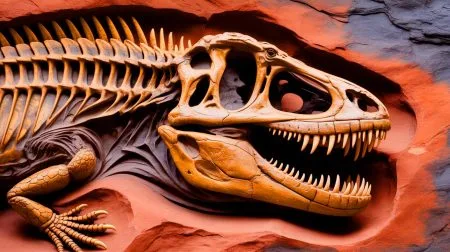| IN A NUTSHELL |
|
In the realm of paleontology, groundbreaking discoveries often reshape our understanding of the distant past. One such discovery is the Agriodontosaurus helsbypetrae, a newly identified species of lizard that dates back 242 million years. Unearthed in Devon, England, this fossil presents a fresh perspective on the evolution of lepidosaurs, a group that includes lizards, snakes, and the tuatara. This finding not only challenges preconceived notions about the early members of this group but also underscores the diversity and complexity of life forms that existed long before the age of dinosaurs. The implications of this discovery are far-reaching, prompting scientists to revisit and revise established evolutionary theories.
The Discovery of Agriodontosaurus Helsbypetrae
The fossil discovery of Agriodontosaurus helsbypetrae in 2015 marked a significant milestone in paleontological research. Recovered from the Helsby Sandstone Formation, this species is now considered the oldest known member of the lepidosaur lineage. The name, meaning “fierce-toothed lizard,” is a testament to the creature’s distinctive dental features. These fossils date back to the Middle Triassic period, a time when the Earth was undergoing significant geological and environmental changes.
The discovery has prompted scientists to question long-held assumptions about the evolutionary history of lepidosaurs. Prior to this finding, it was believed that the first members of this group would exhibit traits similar to modern lizards, such as a hinged jaw and teeth on the roof of the mouth. However, the Agriodontosaurus helsbypetrae fossil tells a different story. As Dan Marke, the project leader, stated, the new animal is unlike anything previously discovered, compelling scientists to reevaluate the evolutionary trajectory of lizards, snakes, and the tuatara.
Unique Anatomical Features
Agriodontosaurus helsbypetrae exhibits a range of unique anatomical features that set it apart from its modern relatives. Unlike the hinged skulls and palatal teeth seen in many contemporary lizards, this ancient specimen had a complete, unhinged skull and large, triangular teeth. These features suggest a different feeding mechanism, likely adapted to a specific ecological niche.
The only trait consistent with early lepidosaur expectations was the presence of an open lower temporal bar, a feature seen in the tuatara but absent in most modern lizards and snakes. This discovery has significant implications for understanding the diversity of feeding strategies among early lepidosaurs. The large, triangular teeth of Agriodontosaurus indicate a capability to pierce tough exoskeletons, similar to the feeding habits of modern tuataras.
Advanced Imaging Techniques
The study of Agriodontosaurus helsbypetrae’s fossil required cutting-edge imaging techniques due to its diminutive size. Traditional X-ray scans fell short in capturing the intricate details of the 1.5-centimeter skull. To overcome this, researchers employed synchrotron CT scans, utilizing facilities in France and the UK. This sophisticated technology allowed scientists to examine the fossil’s features without causing any damage.
The detailed imaging revealed insights into the creature’s feeding adaptations and evolutionary significance. The fossil’s teeth and skull structure provided critical data that contributed to the understanding of early lepidosaur evolution. According to Professor Michael Benton, a co-supervisor on the project, the findings emphasize the diversity of ancient reptilian feeding strategies and highlight the evolutionary significance of the tuatara.
Implications for Evolutionary Biology
The discovery of Agriodontosaurus helsbypetrae has profound implications for the field of evolutionary biology. It challenges the traditional narrative of lepidosaur evolution by showcasing the diversity and adaptability of early lizard lineages. The fossil provides a snapshot of an evolutionary past where diverse feeding strategies were already in place, long before the dominance of modern reptiles.
This finding encourages scientists to rethink the evolutionary relationships between lizards, snakes, and the tuatara. It also raises questions about the environmental pressures that drove the development of such varied anatomical features. As researchers continue to explore the intricacies of ancient life forms, the Agriodontosaurus helsbypetrae serves as a reminder of the complexities and surprises hidden within the Earth’s geological record.
The Agriodontosaurus helsbypetrae offers a compelling glimpse into the evolutionary history of reptiles, challenging established theories and inviting further exploration. As paleontologists continue to unearth new fossils and apply advanced technology, our understanding of ancient life continues to evolve. What other prehistoric secrets lie buried beneath the Earth’s surface, waiting to reshape our understanding of the past?
Did you like it? 4.5/5 (27)







Wow, those teeth sound terrifying! 🦷
Wow, 242 million years old? That’s older than my last phone! 📱
I’m amazed at how much technology has advanced paleontology.
What will happen to the existing theories taught in schools now?
Does this have any implications for the evolution of snakes?
How do we know these features weren’t just anomalies?
Another fossil discovery in England! Is that place a fossil hotspot or what?
Great read, but why haven’t we found more fossils like this?
Is there any evidence of what this lizard’s diet might have been like?
Fascinating! But does “unhinged skull” mean it was a jawless lizard?
Are we sure this isn’t just a deformed fossil? 🤔
Thank you for the detailed explanation. It’s incredible how much we’ve learned!
If these lizards had unhinged skulls, what did they eat?
Between this and the armored fish, paleontology is on fire lately! 🔥
Why aren’t we finding more fossils with these unique features?
Does this discovery affect the timeline of reptile evolution in general?
This discovery is truly mind-blowing! What does it mean for other reptile families?
So, does this mean we need a new dinosaur family on the evolutionary tree? 😂
With so many new discoveries, how do scientists keep up with all the changes?
This is so cool! What other surprises do you think are waiting to be found?
How do these teeth compare to modern reptiles like alligators or crocodiles?
Is there any chance this could be an early ancestor of today’s Komodo dragon?
I’m curious about the ecological niche it might have filled.
Those CT scans sound expensive. Is this research well-funded?
Can someone explain how an unhinged skull works? Sounds terrifying!
Could this discovery lead to changes in how we classify reptiles?